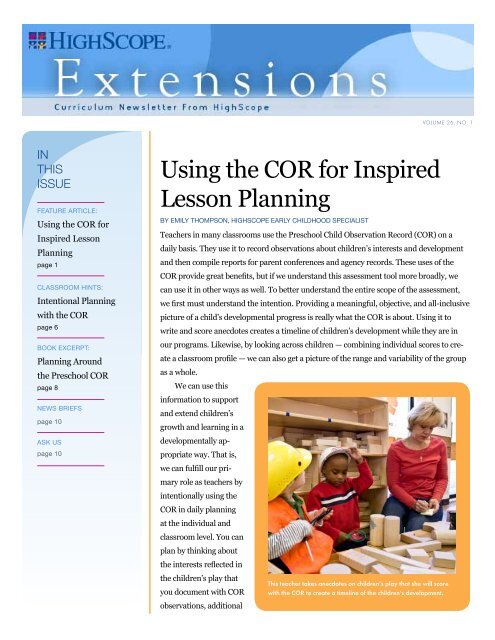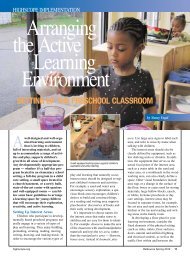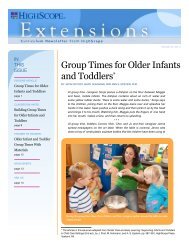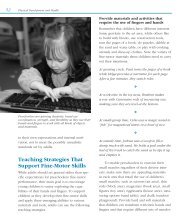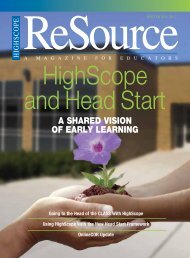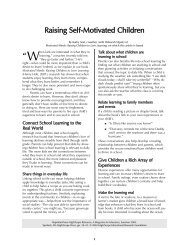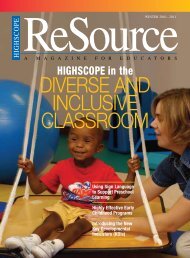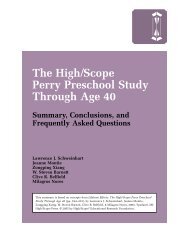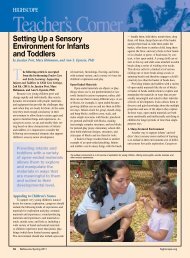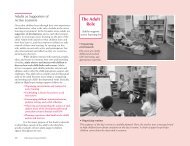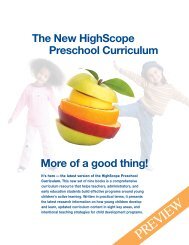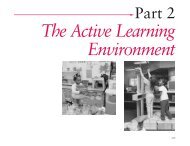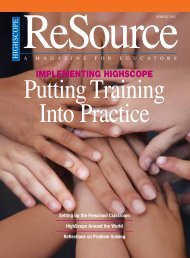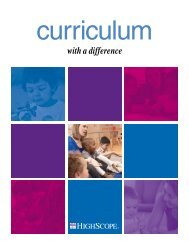Using the COR for Inspired Lesson Planning - HighScope
Using the COR for Inspired Lesson Planning - HighScope
Using the COR for Inspired Lesson Planning - HighScope
You also want an ePaper? Increase the reach of your titles
YUMPU automatically turns print PDFs into web optimized ePapers that Google loves.
In<br />
ThIs<br />
Issue<br />
FEATURE ARTICLE:<br />
<strong>Using</strong> <strong>the</strong> <strong>COR</strong> <strong>for</strong><br />
<strong>Inspired</strong> <strong>Lesson</strong><br />
<strong>Planning</strong><br />
page 1<br />
CLASSROOM HINTS:<br />
Intentional <strong>Planning</strong><br />
with <strong>the</strong> <strong>COR</strong><br />
page 6<br />
BOOK EXCERPT:<br />
<strong>Planning</strong> Around<br />
<strong>the</strong> Preschool <strong>COR</strong><br />
page 8<br />
NEWS BRIEFS<br />
page 10<br />
ASK US<br />
page 10<br />
<strong>Using</strong> <strong>the</strong> <strong>COR</strong> <strong>for</strong> <strong>Inspired</strong><br />
<strong>Lesson</strong> <strong>Planning</strong><br />
By EMILy THOMPSON, HIgHSCOPE EARLy CHILdHOOd SPECIALIST<br />
VOLUME 26, NO. 1<br />
Teachers in many classrooms use <strong>the</strong> Preschool Child Observation Record (<strong>COR</strong>) on a<br />
daily basis. They use it to record observations about children’s interests and development<br />
and <strong>the</strong>n compile reports <strong>for</strong> parent conferences and agency records. These uses of <strong>the</strong><br />
<strong>COR</strong> provide great benefits, but if we understand this assessment tool more broadly, we<br />
can use it in o<strong>the</strong>r ways as well. To better understand <strong>the</strong> entire scope of <strong>the</strong> assessment,<br />
we first must understand <strong>the</strong> intention. Providing a meaningful, objective, and all-inclusive<br />
picture of a child’s developmental progress is really what <strong>the</strong> <strong>COR</strong> is about. <strong>Using</strong> it to<br />
write and score anecdotes creates a timeline of children’s development while <strong>the</strong>y are in<br />
our programs. Likewise, by looking across children — combining individual scores to create<br />
a classroom profile — we can also get a picture of <strong>the</strong> range and variability of <strong>the</strong> group<br />
as a whole.<br />
We can use this<br />
in<strong>for</strong>mation to support<br />
and extend children’s<br />
growth and learning in a<br />
developmentally appropriate<br />
way. That is,<br />
we can fulfill our primary<br />
role as teachers by<br />
intentionally using <strong>the</strong><br />
<strong>COR</strong> in daily planning<br />
at <strong>the</strong> individual and<br />
classroom level. You can<br />
plan by thinking about<br />
<strong>the</strong> interests reflected in<br />
<strong>the</strong> children’s play that<br />
This teacher takes anecdotes on children’s play that she will score<br />
you document with <strong>COR</strong> with <strong>the</strong> <strong>COR</strong> to create a timeline of <strong>the</strong> children’s development.<br />
observations, additional
<strong>Using</strong> <strong>the</strong> <strong>COR</strong> <strong>for</strong> <strong>Inspired</strong> <strong>Lesson</strong> <strong>Planning</strong>, continued<br />
<strong>HighScope</strong> developed <strong>the</strong><br />
Preschool Child Observation<br />
Record (<strong>COR</strong>) in response to<br />
<strong>the</strong> need <strong>for</strong> an early childhood<br />
assessment that would give a<br />
comprehensive portrait of a child’s<br />
developmental progress. The<br />
success of <strong>the</strong> Preschool <strong>COR</strong><br />
helped many different early<br />
childhood programs assess <strong>the</strong>ir<br />
PUBLISHER CREDITS<br />
<strong>HighScope</strong> Extensions is a practical resource <strong>for</strong> early<br />
childhood teachers, trainers, administrators, and child care<br />
providers. It contains useful in<strong>for</strong>mation on <strong>the</strong> <strong>HighScope</strong><br />
Curriculum and on <strong>HighScope</strong>’s training network.<br />
Jennifer Burd<br />
Marcella Weiner<br />
Joanne Tangorra<br />
Editors<br />
Katie Bruckner<br />
Assistant Editor/Assistant Web Specialist<br />
Nancy Brickman<br />
Director of Publications<br />
Kacey Beach<br />
Marketing Specialist<br />
Sherry Barker<br />
Membership Manager<br />
Kathleen Woodard<br />
Director of Marketing and Communication<br />
Produced by <strong>HighScope</strong> Press, a division of <strong>HighScope</strong><br />
Educational Research Foundation<br />
ISSN 2155-3548<br />
children and improve <strong>the</strong>ir<br />
programs (<strong>HighScope</strong> Extensions,<br />
"How <strong>the</strong> Preschool <strong>COR</strong> Can<br />
Work <strong>for</strong> You!"<br />
by Polly Neill, Summer 2004<br />
Vol. 18, No. 6, p. 1).<br />
©2012 <strong>HighScope</strong> Foundation<br />
The <strong>HighScope</strong> Foundation is an independent, nonprofit<br />
organization founded by David Weikart in Ypsilanti, MI<br />
in 1970.<br />
HIGHSCOPE | Extensions<br />
areas of <strong>the</strong> <strong>COR</strong> that you want to expose children to, areas of <strong>the</strong> <strong>COR</strong> where you have<br />
missing data, and areas where <strong>the</strong> scores are consistently low or where you don’t see<br />
much growth occurring.<br />
Blending children’s interests with <strong>the</strong> <strong>COR</strong> can take some thought. When you are<br />
planning a small-group time, review your <strong>COR</strong> anecdotes to see what materials <strong>the</strong> children<br />
in your classroom have been playing with. Then try to incorporate that material<br />
with <strong>the</strong> curriculum content you have in mind when planning your small-group time.<br />
For example:<br />
• Dinosaurs — If children have been interested in using <strong>the</strong> toy dinosaurs and<br />
you want to focus on sorting, you can offer dinosaurs in different shapes and<br />
colors. If <strong>the</strong> interest is dinosaurs and you want to focus on pretend play, you<br />
can add in some props <strong>for</strong> <strong>the</strong> children to tell stories with.<br />
• Water table — If children in your classroom have been playing in <strong>the</strong> water<br />
table a lot and you want to give <strong>the</strong>m more opportunities to name and<br />
recognize letters, you can give children <strong>the</strong>ir own tubs of water, small plastic<br />
letters, and some spoons.<br />
Of course, not all child interests will blend as seamlessly with <strong>COR</strong> areas, and that<br />
is okay! Just make sure that you are planning <strong>for</strong> children’s interests in o<strong>the</strong>r ways<br />
throughout your routine (<strong>for</strong> example, based on <strong>the</strong> curriculum content) and giving<br />
<strong>the</strong>m chances to make <strong>the</strong>ir own choices about <strong>the</strong> play <strong>the</strong>y want to do.<br />
You can also use a computer to analyze this data with <strong>the</strong> Online<strong>COR</strong>. If you are<br />
seeing low scores in particular areas and want to get ideas <strong>for</strong> boosting <strong>the</strong>m, you can<br />
use <strong>the</strong> classroom profile<br />
report. This report lets<br />
you choose which area<br />
of <strong>the</strong> <strong>COR</strong> you want to<br />
look at and <strong>the</strong>n arranges<br />
children’s names according<br />
to levels where you<br />
have scored anecdotes.<br />
For example, it might tell<br />
you that you have scored<br />
Olivia, Kendal, Mat<strong>the</strong>w,<br />
and Robert at a level 2<br />
<strong>for</strong> <strong>COR</strong> item Y. Sorting By analyzing what <strong>the</strong>y note about children’s interests using<br />
<strong>the</strong> <strong>COR</strong>, teachers can identify areas with low scores and<br />
objects; that no children develop ideas <strong>for</strong> boosting <strong>the</strong>m.<br />
are scored <strong>for</strong> a level 3 or<br />
VOLUME 26, NO. 1 • page 2
<strong>Using</strong> <strong>the</strong> <strong>COR</strong> <strong>for</strong> <strong>Inspired</strong> <strong>Lesson</strong> <strong>Planning</strong>, continued<br />
4; and that only Amelia is at a level 5. This type of in<strong>for</strong>mation can really help you identify<br />
specific objectives to plan <strong>for</strong> in <strong>the</strong> classroom and help you see what levels of development<br />
your children are currently at.<br />
Once you have this in<strong>for</strong>mation, you can plan an activity related to sorting and know<br />
how to support children at <strong>the</strong>ir current level while offering gentle extensions of <strong>the</strong>ir<br />
skills. In o<strong>the</strong>r words, you can be more intentional about scaffolding <strong>the</strong>ir learning as you<br />
work toge<strong>the</strong>r during <strong>the</strong> activity. If <strong>the</strong>re is an area of <strong>the</strong> <strong>COR</strong> that you feel you never<br />
take anecdotes <strong>for</strong>, <strong>the</strong> Classroom Score Report in Online<strong>COR</strong> can be very useful. This<br />
report will show you how many anecdotes have been taken <strong>for</strong> each child at a specific<br />
level. So, <strong>for</strong> example, you can see that <strong>for</strong> item M. Moving with objects, you have one<br />
anecdote <strong>for</strong> Ella, none <strong>for</strong> Bryce, two <strong>for</strong> Brady, and none <strong>for</strong> Veronica. Now that you<br />
have confirmed your initial thoughts about missing this <strong>COR</strong> item, discuss with your<br />
teaching team whe<strong>the</strong>r children might be engaging in this area but you are just not seeing<br />
or recording it. On <strong>the</strong> o<strong>the</strong>r hand, you may not be providing enough of <strong>the</strong> materials and<br />
experiences that would encourage <strong>the</strong>m to engage in activities in this area. Then you can<br />
brainstorm with your teaching team about when you might see this item in children’s<br />
work and play during <strong>the</strong> day, and <strong>the</strong> best way to take anecdotes during this time. Or,<br />
you might think about providing materials and planning a large- or small-group time<br />
around this <strong>COR</strong> item.<br />
If you use <strong>the</strong> <strong>COR</strong> kit, you can also make <strong>the</strong>se reports by taking a look at your<br />
Child’s Developmental Summary sheet and focusing on <strong>the</strong> area that you think you are<br />
missing or have low scores <strong>for</strong>. Label a separate piece of paper with levels 1–5* across <strong>the</strong><br />
top. As you scan through your children’s Developmental Summary sheets, you can keep<br />
a tally of <strong>the</strong> levels of <strong>the</strong> anecdotes that you have scored in <strong>the</strong> area you are focusing on.<br />
See <strong>the</strong> example below:<br />
A. Making Choices and Plans<br />
Level 1 Level 2 Level 3 Level 4 Level 5<br />
2 1 1<br />
According to <strong>the</strong> in<strong>for</strong>mation above, most children in this group (6 out of 8) are scoring<br />
at a level 2 or below. You now can take a deeper look into <strong>the</strong> item and see whe<strong>the</strong>r<br />
children need more opportunities to make choices and plans. You can also think about<br />
some strategies that would support children in giving more details about <strong>the</strong>ir plans.<br />
Y. Sorting Objects<br />
Level 1 Level 2 Level 3 Level 4 Level 5<br />
1 1<br />
HIGHSCOPE | Extensions<br />
*Note that <strong>the</strong> chart shown in <strong>the</strong> example illustrates levels 1–5 because it pertains to <strong>the</strong> print versions of <strong>the</strong> <strong>COR</strong>.<br />
Online<strong>COR</strong> uses level 0–5 and will enable users to tabulate similar in<strong>for</strong>mation showing all six levels.<br />
VOLUME 26, NO. 1 • page 3
<strong>Using</strong> <strong>the</strong> <strong>COR</strong> <strong>for</strong> <strong>Inspired</strong> <strong>Lesson</strong> <strong>Planning</strong>, continued<br />
HIGHSCOPE | Extensions<br />
After tallying <strong>the</strong> scores <strong>for</strong> this item, you can see that <strong>the</strong>re are not many anecdotes<br />
taken in this area; you might brainstorm with your teaching team about why this is. After<br />
looking closely at item Y. Sorting objects on <strong>the</strong> <strong>COR</strong>, you can see that <strong>the</strong>re might be certain<br />
materials that would promote sorting. Doing a small-group time with <strong>the</strong>se materials<br />
or simply adding <strong>the</strong>m to <strong>the</strong> classroom environment would support this type of learning.<br />
If you are an Online<strong>COR</strong> user and you think <strong>the</strong> children in your classroom are not<br />
growing or progressing within <strong>the</strong> <strong>COR</strong> framework, you can take a look at <strong>the</strong> Classroom<br />
Score Report. This report gives you a snapshot of <strong>the</strong> <strong>COR</strong> scores <strong>for</strong> all <strong>the</strong> children in<br />
your classroom. Scores are shown <strong>for</strong> each recording period. So this in<strong>for</strong>mation will show<br />
you that <strong>for</strong> A. Making choices and plans, Grace scored a 3 <strong>for</strong> <strong>the</strong> first recording period<br />
and a 3 <strong>for</strong> <strong>the</strong> second recording period. We can clearly see that <strong>the</strong>re is no growth <strong>for</strong><br />
Grace in this area. For manual <strong>COR</strong> users, this report can be completed by first filling out<br />
<strong>the</strong> Developmental Summary <strong>for</strong> all <strong>the</strong> children in your classroom and <strong>the</strong>n compiling<br />
<strong>the</strong>se summaries. In <strong>the</strong> example below, you can see <strong>the</strong> reporting periods (1–4) <strong>for</strong> each<br />
item, and <strong>the</strong> highest scores <strong>for</strong> <strong>the</strong> children Grace and Anna. This report can show you<br />
where <strong>the</strong>re is no growth, where children have decreased in scores, and where <strong>the</strong>y are<br />
showing growth.<br />
I. Initiative<br />
A. Making<br />
choices and<br />
plans<br />
B. Solving<br />
problems with<br />
materials<br />
C. Initiating<br />
play<br />
D. Taking care of<br />
personal needs<br />
Reporting period 1 2 3 4 1 2 3 4 1 2 3 4 1 2 3 4<br />
Grace 3 3 4 3 2 2 3 4<br />
Anna 2 3 3 4 1 2 2 2<br />
Running and compiling<br />
<strong>the</strong>se types of reports can be very<br />
helpful <strong>for</strong> you in using your <strong>COR</strong><br />
data in a more meaningful way.<br />
Make sure you are looking at this<br />
in<strong>for</strong>mation often so that you have<br />
updated in<strong>for</strong>mation with which<br />
to plan. We know children can<br />
grow very quickly, so we suggest<br />
looking at <strong>the</strong>se reports about<br />
every two weeks. Since you are<br />
entering anecdotes daily, you will<br />
Analyzing <strong>COR</strong> data can help teachers support children at<br />
<strong>the</strong>ir current level of development while encouraging <strong>the</strong>m<br />
to take <strong>the</strong> next step.<br />
VOLUME 26, NO. 1 • page 4
<strong>Using</strong> <strong>the</strong> <strong>COR</strong> <strong>for</strong> <strong>Inspired</strong> <strong>Lesson</strong> <strong>Planning</strong>, continued<br />
HIGHSCOPE | Extensions<br />
also be able to keep tabs on <strong>the</strong> in<strong>for</strong>mation that way. You don't have to <strong>for</strong>mally compile<br />
<strong>COR</strong> scores every few weeks, but it is helpful to be looking at <strong>the</strong>m on a regular basis.<br />
However, if you only compile <strong>the</strong> scores three to four times per year, you can't use <strong>the</strong><br />
<strong>COR</strong> to support children's development.<br />
<strong>Using</strong> <strong>the</strong> <strong>COR</strong> more effectively and efficiently can help you plan <strong>for</strong> supporting<br />
children at <strong>the</strong>ir individual levels while giving <strong>the</strong>m <strong>the</strong> confidence to take <strong>the</strong> next step in<br />
<strong>the</strong>ir development!<br />
Emily Thompson is an early childhood specialist, certified teacher, and<br />
certified trainer at <strong>the</strong> <strong>HighScope</strong> Educational Research Foundation in<br />
Ypsilanti, Michigan. In her work with <strong>HighScope</strong>, Emily writes articles <strong>for</strong><br />
<strong>the</strong> Foundation’s curriculum newsletter, Extensions, facilitates online courses,<br />
develops trainings, and aligns <strong>the</strong> <strong>HighScope</strong> Curriculum with state and<br />
national standards. She also served on <strong>the</strong> team that developed <strong>the</strong><br />
key developmental indicators, which <strong>for</strong>m <strong>the</strong> content of <strong>the</strong> <strong>HighScope</strong><br />
Preschool Curriculum. Emily is also a public elementary school teacher in<br />
Dexter, Michigan, and previously taught in <strong>the</strong> <strong>HighScope</strong> Demonstration<br />
Preschool. She credits her knowledge about children and what <strong>the</strong>y need<br />
developmentally to <strong>the</strong>se experiences. Emily says she “learned what to<br />
teach in college and how to teach from <strong>HighScope</strong>.”<br />
Click here <strong>for</strong> entire newsletter<br />
VOLUME 26, NO. 1 • page 5
Intentional <strong>Planning</strong> With <strong>the</strong> <strong>COR</strong><br />
By EMILy THOMPSON, HIgHSCOPE EARLy CHILdHOOd SPECIALIST<br />
Once you have looked through your <strong>COR</strong> reports and have an understanding<br />
of where <strong>the</strong> children in your classroom are, developmentally,<br />
you can use this in<strong>for</strong>mation to plan <strong>for</strong> your day. Many teachers<br />
tend to plan large- and small-group activities <strong>for</strong> <strong>the</strong>ir day, but<br />
we should also be planning strategies to support children throughout<br />
<strong>the</strong> day. When looking at a classroom daily plan (sample at right),<br />
you can see that some parts of <strong>the</strong> day will be planned with activities<br />
(including introductions, support strategies, content areas, and<br />
materials) and that o<strong>the</strong>r parts of <strong>the</strong> day will be planned <strong>for</strong> with reminders<br />
of observations to make, children to support, or adult-child<br />
interaction strategies to remember to use. Read <strong>the</strong> scenario below<br />
(and look at <strong>the</strong> sample “spreadsheets” in <strong>the</strong> lead article) to gain an<br />
understanding of <strong>the</strong> planning process of Karen, a teacher:<br />
Children have been interested in playing with <strong>the</strong> cat and dog<br />
figures. They have been building <strong>the</strong>m houses and finding things<br />
to give <strong>the</strong>m as food. After running my reports from yesterday, I<br />
learned that many children in my group are scoring low in item A.<br />
Making choices and plans. I want to try and help children think about<br />
more details in <strong>the</strong>ir plan. I also learned that I am missing anecdotes<br />
<strong>for</strong> N. Feeling and expressing steady beat, and I would like to plan<br />
an activity <strong>for</strong> this item so that I can take some more anecdotes. The<br />
reports also told me that children are not growing in item V. <strong>Using</strong><br />
letter names and sounds. I would like to support this area more<br />
throughout <strong>the</strong> routine.<br />
CLASSROOM HINTS<br />
Adults: Karen and Page<br />
Greeting Time:<br />
At door talking to parents:<br />
Karen<br />
On carpet reading books with<br />
children: Page<br />
Transition: By letters in<br />
children’s names: “If you have<br />
a B in your name you can go to<br />
your planning table.”<br />
<strong>Planning</strong> Time (Karen)<br />
Have children roll a die that<br />
has numbers 1–3 on it. Have<br />
<strong>the</strong>m tell me that number of<br />
details about <strong>the</strong>ir plan.<br />
HIGHSCOPE | Extensions<br />
Child Messages <strong>for</strong> message<br />
board:<br />
1) New foam blocks in block<br />
area<br />
<strong>Planning</strong> Time (Page)<br />
Place area signs on <strong>the</strong> table<br />
with some blocks around <strong>the</strong>m<br />
like walls. Give children a dog<br />
or cat to place on <strong>the</strong> area<br />
where <strong>the</strong>y want to play. Then<br />
<strong>the</strong>y can tell <strong>the</strong>ir plan.<br />
Work Time<br />
Support <strong>the</strong> pretend play with cats and dogs.<br />
Help children use new blocks within <strong>the</strong>ir play.<br />
Cleanup<br />
Have children clean up to music that is fast and slow; <strong>the</strong>y can<br />
clean fast or slow with <strong>the</strong> pace of <strong>the</strong> music.<br />
Recall Time (Karen)<br />
Children can use <strong>the</strong> recall<br />
wheel (round cardboard with<br />
area signs drawn on) and place<br />
a clip on <strong>the</strong> area where <strong>the</strong>y<br />
played.<br />
Recall Time (Page)<br />
Children will use two cell<br />
phones to “call” each o<strong>the</strong>r and<br />
tell each o<strong>the</strong>r what <strong>the</strong>y did at<br />
work time.<br />
Snack: Juice, water, apples<br />
Karen and Page: Read an alphabet book<br />
Large-Group Time<br />
Easy-to-join activity: Sing <strong>the</strong> song “We’re jumping, jumping,<br />
jumping. We’re jumping, jumping, jumping. We’re jumping,<br />
jumping, jumping, and now we stop.” Sing <strong>the</strong> song a few different<br />
ways and <strong>the</strong>n get children’s ideas of ways to move.<br />
Songbook: Today is Brian’s turn to choose a song. Watch and<br />
take notes about who can keep a steady beat to <strong>the</strong> song.<br />
Activity: Tell a story about cats and dogs. The children can act<br />
out <strong>the</strong> story as we tell <strong>the</strong> parts; <strong>the</strong>y can also add ideas to <strong>the</strong><br />
story about what is going to happen next.<br />
(continued pg.7)<br />
VOLUME 26, NO. 1 • page 6
Classroom Hints, continued<br />
Large-Group Time (continued)<br />
Transition: Have children move to <strong>the</strong>ir small-group tables by<br />
colors of <strong>the</strong>ir clothing.<br />
Small-Group Time<br />
(Karen)<br />
Content: <strong>Using</strong> letter names<br />
and sounds<br />
Materials: Wooden tracing<br />
letters, crayons and paper<br />
Earlier level of development:<br />
Children will say some random<br />
letters<br />
Middle level of development:<br />
Children name more letters<br />
<strong>the</strong>y are looking at or tracing.<br />
Later level of development:<br />
Children ask how to spell a<br />
particular word and name <strong>the</strong><br />
first letter in <strong>the</strong> word.<br />
Outside Time<br />
Get out bikes; sandbox or sand table toys.<br />
Small-Group Time (Page)<br />
Content: Pretend play; language<br />
Materials: Cats, dogs, foam<br />
blocks<br />
Earlier level of development:<br />
Children use materials and say<br />
a few words, mostly playing by<br />
<strong>the</strong>mselves.<br />
Middle level of development:<br />
Children use words and actions<br />
while pretending, and<br />
will add more details to <strong>the</strong>ir<br />
play.<br />
Later level of development:<br />
Children pretend with o<strong>the</strong>r<br />
children and have a story line.<br />
They add a lot of details to<br />
<strong>the</strong>ir play.<br />
Support pretend play happening outside; remind children <strong>the</strong>y<br />
can bring out toys from <strong>the</strong> room outside.<br />
Things to remember<br />
Remind parents to start bringing warm clo<strong>the</strong>s <strong>for</strong> outside time.<br />
HIGHSCOPE | Extensions<br />
Reading through <strong>the</strong> scenario and daily plan can help you see<br />
how using your <strong>COR</strong> data can make your planning more intentional.<br />
You can also start to see how <strong>the</strong> particular times of day are<br />
planned <strong>for</strong>:<br />
Greeting time: Interaction strategies, messages<br />
to share with children, reminders of things to look<br />
<strong>for</strong>, materials to add to <strong>the</strong> classroom<br />
<strong>Planning</strong> time: Strategies, reminders of things<br />
to look <strong>for</strong><br />
Work time: Interaction strategies, materials<br />
children might use<br />
Recall time: Strategies, reminders of things to<br />
look <strong>for</strong><br />
Click here <strong>for</strong> entire newsletter<br />
Small-group time: Activities, reminders of<br />
things to look <strong>for</strong>; how to scaffold children at ear-<br />
lier, middle, and later levels of development<br />
Large-group time: Activities, reminders of<br />
things to look <strong>for</strong><br />
Outside time: Materials<br />
Mealtimes: Interaction strategies, books to read<br />
As teachers, we want to make sure that we are being intentional<br />
about our whole day, without over planning. Children will still<br />
make choices and manipulate materials in <strong>the</strong>ir own ways during<br />
all <strong>the</strong>se times, so our intentions <strong>for</strong> an activity or use of materials<br />
may not be fulfilled. This is okay — remember that children are<br />
learning just by doing. If we don’t get <strong>the</strong> anecdotes we are looking<br />
<strong>for</strong> on a particular day, that often means that children are not ready<br />
<strong>for</strong> whatever our intentions are, or that <strong>the</strong>ir interests are leading<br />
<strong>the</strong>m in ano<strong>the</strong>r direction. We can learn from what children are<br />
doing today, and we will get those anecdotes ano<strong>the</strong>r day or time<br />
provided we intentionally plan opportunities that can capture children’s<br />
interests when <strong>the</strong>y are ready!<br />
VOLUME 26, NO. 1 • page 7
BOOK ExCERPT<br />
<strong>Planning</strong> Around <strong>the</strong> Preschool <strong>COR</strong><br />
The following is an excerpt from <strong>HighScope</strong>’s new book <strong>Planning</strong> Around <strong>the</strong> Preschool <strong>COR</strong> by Emily Thompson.<br />
Category IV. Movement and Music<br />
ITEM M. Moving with objects<br />
1. Child throws or kicks an object.<br />
2. Child catches an object.<br />
3. Child coordinates both hands to<br />
manipulate one or more objects.<br />
4. Child dribbles a ball.<br />
5. Child strikes a moving object with a bat<br />
or paddle.<br />
<strong>Planning</strong> Time<br />
Activity: <strong>Planning</strong> With Area Signs<br />
Materials: Area signs; buckets or baskets.<br />
Place area signs on large buckets or baskets. Have children throw<br />
a soft ball into <strong>the</strong> bucket with <strong>the</strong> area sign of where <strong>the</strong>y want to<br />
play.<br />
Suggestions <strong>for</strong> English Language Learners (ELL): Ask <strong>the</strong> child’s<br />
family <strong>for</strong> translations of <strong>the</strong> different classroom interest areas. Use<br />
<strong>the</strong>se translations and <strong>the</strong> classroom language as you plan with <strong>the</strong><br />
children.<br />
Activity: Making Area Signs <strong>for</strong> <strong>Planning</strong><br />
Materials: Markers; paper; scissors.<br />
Draw area signs with markers on a piece of paper and make enough<br />
copies <strong>for</strong> your planning group. Have children cut out <strong>the</strong> sign <strong>for</strong><br />
<strong>the</strong> area in which <strong>the</strong>y want to play. Watch and see who uses both<br />
hands while doing this — one to hold <strong>the</strong> paper and one to cut <strong>the</strong><br />
paper.<br />
Special Needs Accommodations: Have adaptive scissors to accommodate<br />
children with varying fine-motor abilities. These scissors<br />
spring open and can be easier to use <strong>for</strong> some children.<br />
Activity: Stringing Beads<br />
Materials: Beads; string; masking tape.<br />
Have children string beads on strings that have been labeled with<br />
area symbols. You can label <strong>the</strong> strings by making masking tape tabs<br />
and drawing <strong>the</strong> symbols on <strong>the</strong>m.<br />
Work Time<br />
Strategy:<br />
Incorporate soft balls or beanbags into some areas. Allow children to<br />
toss <strong>the</strong>se objects into buckets or to each o<strong>the</strong>r.<br />
HIGHSCOPE | Extensions<br />
Strategy:<br />
Provide a lot of clo<strong>the</strong>s <strong>for</strong> children to dress dolls in. Observe as <strong>the</strong>y<br />
use both hands to fasten <strong>the</strong> buttons, Velcro, etc.<br />
Strategy:<br />
Add small toys that can be put toge<strong>the</strong>r and taken apart, <strong>for</strong> example,<br />
nuts and bolts, Legos, Tinker Toys, and so <strong>for</strong>th.<br />
Strategy:<br />
Create a woodworking area, or incorporate woodworking materials<br />
into <strong>the</strong> art area — <strong>for</strong> example, screwdrivers and screws, hammers<br />
and nails (or golf tees and Styrofoam), and appliances to take apart.<br />
Recall Time<br />
Activity: Playing Hot Potato<br />
Materials: One small beanbag or a soft ball.<br />
Use a small beanbag or a soft ball. Play a version of “hot potato.”<br />
Toss <strong>the</strong> beanbag to children and have <strong>the</strong>m toss it to o<strong>the</strong>r children.<br />
When you say “Freeze,” <strong>the</strong> child with <strong>the</strong> beanbag recalls.<br />
Activity: Making Area Signs <strong>for</strong> Recall<br />
Materials: Markers; paper; scissors.<br />
Draw area signs on a piece of paper and make enough copies <strong>for</strong><br />
your planning group. Have children cut out <strong>the</strong> sign <strong>for</strong> <strong>the</strong> area in<br />
which <strong>the</strong>y played. Observe to see who uses both hands while doing<br />
this — one to hold <strong>the</strong> paper and one to cut <strong>the</strong> paper.<br />
Activity: Recalling With a Ball<br />
Materials: Ball.<br />
Sit toge<strong>the</strong>r with children in a circle and roll a ball to a child <strong>for</strong> his<br />
or her turn to recall. After recalling, <strong>the</strong> child <strong>the</strong>n rolls <strong>the</strong> ball to<br />
ano<strong>the</strong>r child.<br />
Large-Group Time<br />
Activity: Kicking Balloons<br />
Materials: Balloons — enough <strong>for</strong> each child, and extras in case<br />
some pop (blow <strong>the</strong>m up in advance of activity).<br />
Have children kick <strong>the</strong> balloons around <strong>the</strong> large-group area. Balloons<br />
are soft enough that <strong>the</strong>y will not hurt children or materials<br />
around <strong>the</strong> area.<br />
Activity: Moving With Materials<br />
Materials: Soft balls or balloons; paper towel tubes (one of each<br />
material <strong>for</strong> each child).<br />
VOLUME 26, NO. 1 • page 8
Classroom Hints, continued<br />
Have children go outside and play with soft balls or balloons and<br />
paper towel tubes. Children can choose how to move with <strong>the</strong> materials;<br />
<strong>the</strong>y might toss and catch <strong>the</strong> balls, hit <strong>the</strong>m with <strong>the</strong> tubes, or<br />
kick <strong>the</strong> balls.<br />
Activity: Playing With Rubber Balls<br />
Materials: Large rubber balls; buckets or hoops.<br />
Use large rubber balls on a hard surface, such as <strong>the</strong> gym floor or<br />
Small-Group Time<br />
Developmental Range <strong>for</strong> Playing Basket Toss: What You May See Children Doing<br />
Earlier (level 1–2) Middle (level 3–4) Later (level 5)<br />
Children may<br />
• Throw <strong>the</strong> ball toward <strong>the</strong> basket.<br />
• Throw <strong>the</strong> ball up in <strong>the</strong> air and<br />
catch it.<br />
• Catch <strong>the</strong> ball that ano<strong>the</strong>r child, or you,<br />
toss to him or her.<br />
Children may<br />
• Throw <strong>the</strong> ball into <strong>the</strong> basket.<br />
• Dribble <strong>the</strong> ball on <strong>the</strong> ground, <strong>the</strong>n throw<br />
it into <strong>the</strong> basket.<br />
Click here <strong>for</strong> entire newsletter<br />
HIGHSCOPE | Extensions<br />
pavement outside. Introduce buckets or hoops <strong>for</strong> children to toss<br />
balls into.<br />
Activity: Kicking Balls<br />
Materials: Balls, enough <strong>for</strong> each child.<br />
Kick balls in large grassy areas.<br />
Activity: Marching With Musical Instruments<br />
Materials: Musical instruments.<br />
March, as in a parade, with instruments.<br />
Activity: Playing Basket Toss<br />
Materials: Baskets <strong>for</strong> each child; soft balls.<br />
Have children play “basket toss”: <strong>the</strong>y can toss <strong>the</strong>ir ball into <strong>the</strong>ir basket. Children can also keep <strong>the</strong>ir “score” on a board if <strong>the</strong>y want.<br />
Children may<br />
• Throw <strong>the</strong> ball up in <strong>the</strong> air and hit it with<br />
<strong>the</strong>ir hand or kick it with <strong>the</strong>ir foot.<br />
• Walk and dribble <strong>the</strong> ball toward <strong>the</strong><br />
basket.<br />
Activity: Cutting Out Pictures<br />
Materials: Scissors; magazines; envelopes.<br />
Have children cut out pictures from magazines. They can choose what <strong>the</strong>y want to cut out. Children may want to place <strong>the</strong>ir cuttings in an<br />
envelope.<br />
Special Needs Accommodations: Have spring-loaded scissors available <strong>for</strong> children who have varying fine motor abilities.<br />
Developmental Range <strong>for</strong> Cutting Out Pictures: What You May See Children Doing<br />
Earlier (level 1–2) Middle (level 3–4) Later (level 5)<br />
Children may<br />
• Tear <strong>the</strong> paper with <strong>the</strong>ir fingers.<br />
• Use two hands to open and close <strong>the</strong><br />
scissors.<br />
Outside Time<br />
Strategy:<br />
Incorporate materials that children can easily kick, throw, or bat.<br />
Children may<br />
• Make small snips along <strong>the</strong> edge of <strong>the</strong><br />
paper, like fringe.<br />
• Use one hand to move or hold <strong>the</strong><br />
paper and one hand to open and close <strong>the</strong><br />
scissors.<br />
Children may<br />
• Cut around a picture using one hand to<br />
manipulate <strong>the</strong> scissors and <strong>the</strong> o<strong>the</strong>r hand<br />
to turn <strong>the</strong> picture.<br />
VOLUME 26, NO. 1 • page 9
NEWS BRIEFS<br />
Dr. Tomoko Wakabayashi Named Director of Research<br />
Dr. Tomoko Wakabayashi has been named Director of Research of<br />
<strong>the</strong> <strong>HighScope</strong> Educational Research Foundation, it was announced<br />
by Dr. Larry Schweinhart, <strong>HighScope</strong> president.<br />
Dr. Wakabayashi is an experienced educational researcher with<br />
expertise in assessment and program evaluation. Her post-doctoral<br />
research experience includes work at <strong>the</strong> Center <strong>for</strong> Infant Studies at<br />
Stan<strong>for</strong>d University. She has extensive experience in higher education<br />
teaching and has served as <strong>the</strong> lead evaluator <strong>for</strong> a federally<br />
funded five-year responsible fa<strong>the</strong>rhood project.<br />
Prior to joining <strong>HighScope</strong>, Dr. Wakabayashi served as research<br />
manager <strong>for</strong> Parents as Teachers, was a lecturer in <strong>the</strong> Child and<br />
Adolescent Development Department of San Jose State University,<br />
and served as a Postdoctoral Research Coordinator in <strong>the</strong> Center <strong>for</strong><br />
Infant Studies in <strong>the</strong> Department of Psychology at Stan<strong>for</strong>d University.<br />
A Magna Cum Laude graduate of Sophia University in Tokyo,<br />
Japan, Dr. Wakabayashi earned a Master’s Degree in Child Study<br />
at Tufts University, was a research student at Kyoto University in<br />
Kyoto, Japan, and earned both a Masters of Education and a Doctor<br />
of Education Degree in Human Development and Psychology from<br />
Harvard University Graduate School of Education in Cambridge,<br />
Massachusetts.<br />
“We are very pleased to have Dr. Tomoko Wakabayashi as<br />
<strong>HighScope</strong>’s new Director of Research,” noted Schweinhart. “Her<br />
problem-solving orientation, research interests, experience, and educational<br />
background fit well with <strong>HighScope</strong>’s character and culture,”<br />
he added.<br />
Online<strong>COR</strong> Updates<br />
You may have noticed some changes in Online<strong>COR</strong> – that is<br />
because we are in <strong>the</strong> last step of testing, which is a “live” test of <strong>the</strong><br />
new features being introduced. We hope you find many of <strong>the</strong> new<br />
features useful in your work with children.<br />
The January release includes:<br />
Teacher <strong>Planning</strong> Form — A new interactive teacher planning<br />
<strong>for</strong>m is available! Teachers may create, edit, and save daily lesson<br />
plans.<br />
(continued pg.11)<br />
By KAREN “KAy” RUSH<br />
Click here <strong>for</strong> entire newsletter<br />
ASK US<br />
HIGHSCOPE | Extensions<br />
Although this year’s gain scores were <strong>the</strong> same<br />
as last year, our overall scores weren’t as strong.<br />
Should I be concerned?<br />
— A Preschool Teacher<br />
We applaud your awareness of your children’s <strong>COR</strong> scores<br />
from this year compared to previous years. However, we<br />
think <strong>the</strong>re is no cause <strong>for</strong> concern at this time. Your children’s<br />
gain scores are <strong>the</strong> same, so one could say that your<br />
program is having <strong>the</strong> same impact this year compared to<br />
last year. If you look at your first set of <strong>COR</strong> scores, you will<br />
see that <strong>the</strong>y were lower than <strong>the</strong> previous year. In o<strong>the</strong>r<br />
words, <strong>the</strong> children started at a lower level but you were<br />
equally effective in supporting and advancing <strong>the</strong>ir development.<br />
VOLUME 26, NO. 1 • page 10
NEWS BRIEFS (continued)<br />
• Now you can make your own daily plan online — create and/or<br />
manage a daily routine that reflects your classroom schedule.<br />
We have added an advanced search option so you can easily find<br />
activities and strategies by topic, Preschool <strong>COR</strong> category or<br />
item, learning center, or routine.<br />
• New activities and strategies from <strong>HighScope</strong>’s new book,<br />
<strong>Planning</strong> Around <strong>the</strong> Preschool <strong>COR</strong>, provide a library of<br />
activities <strong>for</strong> possible inclusion in your lesson plan. Add your<br />
own activities to <strong>the</strong> online lesson plan — activities added by<br />
teachers show up in “My Activities” <strong>for</strong> later retrieval.<br />
• Review planning reminders entered on child records in <strong>the</strong><br />
“View Notes” link to aid in individualized planning. See more<br />
details below.<br />
• Associate a lesson plan with a particular topic. From <strong>the</strong> keyword<br />
search, <strong>the</strong> lesson plans will appear in <strong>the</strong> topic search results<br />
and can be added to <strong>the</strong> daily plan by simply dragging <strong>the</strong> result<br />
to <strong>the</strong> plan window.<br />
<strong>Planning</strong> Reminders to Help Teachers With Individualized<br />
<strong>Planning</strong> — When entering an anecdote, teachers may now<br />
enter a planning reminder <strong>for</strong> individual children. The notes can be<br />
reviewed in <strong>the</strong> new lesson planner and make planning <strong>for</strong> each child<br />
easier and more meaningful.<br />
Mobile App — Online<strong>COR</strong> Mobile is a new add-on feature <strong>for</strong><br />
Online<strong>COR</strong>.net users and runs on iOS (iPAD ® ) and Android ® tablet<br />
devices. Syncing between Online<strong>COR</strong> Mobile and Online<strong>COR</strong>.net<br />
requires access to a wireless hotspot. Once synced, <strong>the</strong> Online<strong>COR</strong><br />
Mobile application can be used to enter and score anecdotes <strong>for</strong><br />
children in your classroom while offline. When finished entering<br />
anecdotes, you will locate a hot spot and sync your tablet with<br />
Online<strong>COR</strong> to upload your latest anecdotes to Online<strong>COR</strong>.net. Soon<br />
<strong>the</strong> Online<strong>COR</strong> Mobile App will be available to download from <strong>the</strong><br />
iTunes ® or Android Market ® stores; watch <strong>for</strong> future Online<strong>COR</strong><br />
announcements.<br />
Click here <strong>for</strong> entire newsletter<br />
HIGHSCOPE | Extensions<br />
Head Start Reporting — Head Start reports at <strong>the</strong> cassroom<br />
level and above now include a new report page based on <strong>the</strong> Head<br />
Start approach to school readiness.<br />
Teacher User Guide — The Teacher User Guide located in <strong>the</strong><br />
“Toolbox” has been updated with instructions <strong>for</strong> <strong>the</strong> new January<br />
2012 features.<br />
OSEP — The method of identifying scores <strong>for</strong> OSEP purposes<br />
has been changed. A new Manage OSEP Scores has been added<br />
to <strong>the</strong> Anecdotes section of <strong>the</strong> teacher home page. <strong>Using</strong> this<br />
option, <strong>the</strong> teacher will be able to review anecdotes entered in<br />
during a selected time period(s) and record <strong>the</strong> score that best<br />
represents <strong>the</strong> child’s entry or exit skill based on <strong>the</strong> scores entered.<br />
Users can change time periods and school years to correct<br />
<strong>for</strong> missing data. Users will no longer identify individual anecdotes<br />
as entry or exit when entering anecdotes.<br />
OnlinePQA — The Program Quality Assessment (PQA) may<br />
now be accessed from within <strong>the</strong> Online<strong>COR</strong> application (requires<br />
a separate license). Visit OnlinePQA to learn more.<br />
If you have questions or comments, please feel free to contact<br />
us. Technical support is also available if you have questions about<br />
any of <strong>the</strong> new features — 888.386.3822 (option 5), M–F 8:00<br />
a.m.–5:00 p.m. EST.<br />
Mark your calendar now <strong>for</strong> <strong>the</strong> 2012<br />
<strong>HighScope</strong> International Conference!<br />
The conference is scheduled <strong>for</strong><br />
May 2–4, 2012, with preconference<br />
sessions taking place April 30—May 1.<br />
VOLUME 26, NO. 1 • page 11


